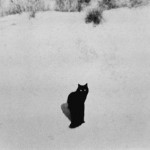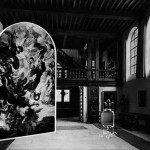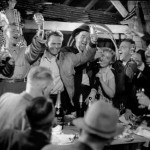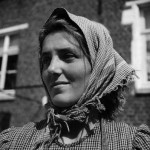Interview by Andrée Tournès
Interview with Henri Storck
Extracts from an interview by Andrée Tournès published
in the review Jeune Cinéma, Paris, n° 188 and 189,
May-June and July-August 1988.
Fiction-documentary
 Do you consider yourself to be a documentary maker and only a documentary maker?
Do you consider yourself to be a documentary maker and only a documentary maker?
To my mind, the words documentary maker and fiction are arbitrary designations. There are no clear borders between the two. Real life is full of what we in cinema call fiction, that’s to say characters are often staged, they play roles, with well-rehearsed dialogues, there is a decor, an action, a ritual. This is true of everything that happens in a courtroom, a hospital, a police station, a convent, an office, a shop. This sort of fiction has been shown admirably well by the great documentary makers such as Fred Wiseman or Raymond Depardon.
But documentary has its limits. I once pointed out that documentary, which by its very nature is destined to read all that is real, is banned from filming the most powerful realities of human life: violence, murder, sadism, love, death, madness. Those are all secret acts.
It is probably because of this basic obstacle in the cinema of the real that the same prohibited subject matters are shown profusely in fiction films. For in fiction the roles are reversed: reality is the film being made; the real thing is the scene being filmed; the master is the camera. So it becomes possible to represent everything. The death of the main character is not the death of a man, passionate love is not experienced but acted, and violence is mimed. But that doesn’t mean these representations are any the less disturbing.
Nevertheless, in documentary films, the feeling of reality is so powerful that this image from real life, from a real situation experienced by the beings who really endure or carry out an action instead of just acting it out, holds great fascination for the spectator. It is no less powerful than that of the fiction film, which pulls off the miracle of the true.
This sort of cinema has many facets. It can be the privileged witness of an exceptional event that it captures as it happens and which gives birth to a document of unquestionable, sometimes unbearable power; or after having studied, observed and understood reality, it can organise the way to possess it with the consent of the characters of this real action, by holding them faithful to their truth, by encouraging their spontaneity, by avoiding any form of manipulation. That’s what Luc de Heusch called the participating camera.
The camera that lacks respect for human beings distorts the truth. If these principles are respected, there is no objection to the meticulous reconstitution or staging of scenes. That was the method used by Flaherty. Sometimes the reconstitution, through its quality of truth, constitutes a new reality, an action that the protagonists will experience as real and not acted.
Nevertheless, documentary narration obeys the same laws as fictional narration. Most procedures of cinematographic language were perfected by the early documentary makers and, notably, by Dziga Vertov. They developed such techniques as slow-motion, accelerated motion, superimpositions, deformations of images, the effects of rhythm, the use of ellipses, reverse motion, etc.
All of which leads one to believe that documentaries and fiction films are complementary, each taking strength from the other. There are poets, visionaries and prophets in both camps.
So, what is the border between documentary and fiction? I find it impossible to give a clear answer to the question. In films of pure imagination, such as horror films or fantastic films, films of anticipation or science fiction, there are always a certain number of elements borrowed from reality, which usually belong to the realm of documentary. Sometimes these elements stand the test of time better than fiction.
Silent cinema
 I must admit I feel some nostalgia for the wonderful twenties when cinema truly became a universal language thanks to the magic of images, the music of images as Abel Gance put it.
I must admit I feel some nostalgia for the wonderful twenties when cinema truly became a universal language thanks to the magic of images, the music of images as Abel Gance put it.
Silent cinema had established perfect narrative forms and remarkable filming techniques. At the time of the silent movies, you could say that a deaf person heard what a mute person had to say to him. And the height of the art was to make films without any title cards. (…)
I was part of that generation of young filmmakers at the end of the twenties who lived through the painful passage from silent to talking films. One had to adapt very quickly. My film Images d’Ostende, shot during the winter 1929 – 1930 is purely visual (people have said it was something akin to music). In any case, it is a film for which there exists no solution in terms of sound, it tolerates no music, no music goes with the images and anything that could be added in terms of noise or speech would only destroy a sort of visual poetry that emanates from it.
As for Idlylle à la plage, filmed in 1931, it is still basically a silent film, which includes only a few noises that serve as sound gags, but no ambient sounds. It is accompanied by a fresh and intelligent music composed by Manuel Rosenthal, and a few brief words that act as sub-titles to help understand the anecdote and which were spoken during the recording of the music. Indeed, mixing didn’t exist at that time.
Borinage, filmed by Ivens and myself in 1933, was a purely silent film, interspersed with title cards. The effect was powerful. The titles created a rhythm; they provided information about and gave meaning to the images, which were intended to produce emotion.
At the beginning of the sixties, in order to facilitate the distribution of the film, the title cards were replaced by a spoken commentary. It was very difficult to find the right tone and create an atmosphere as effective as the title cards, even though the commentary used exactly the same text.
Yet, at the time of creating the film, Ivens and I had wanted to ask Bertolt Brecht to write a prologue and Hans Eisler to compose some music. Eisler had just composed the music for New Earth, Ivens’ film on Zuyderzee. But circumstances (that year Brecht’s books were burned in Berlin and he fled to Denmark) and the lack of funding prevented us from doing so. Recently, the German film historian, Lothar Prox, invited André Asriel, a former pupil of Eisler, to write some music for Borinage.
Naturally, after so many years, this film has lost some of its accusing sting and has become a historical document about a revolting situation. Asriel’s music, which is of great quality and precisely in the style of Eisler, adds a feeling of revolutionary exaltation to the film and it does not do it disservice, but it does perhaps take away some of the implacability and irrefutability of the document. It is a good example of how to shift a rigorous document towards something resembling a lyrical pamphlet.
Does it remove some of its credibility or on the contrary, does it exalt the spectator’s feelings?
Whatever the case may be, I know Ivens is not in favour of it.
On this subject, I would like to add that in the thirties, the weak point of the documentary was precisely its soundtrack. Today when one sees a documentary from that period, often only the image remains and triumphs, preserves its charm, its seduction, its eloquence and truth, its sense of depth. In the early days of sound, we fell into the opposite trap. All of a sudden we thought that images needed support and that their impact needed to be reinforced by a certain literary and musical commentary. But we could never manage to find a natural tone, a language that didn’t damage the images. Silence seemed incongruous to us and sound vulgar, ordinary and lacking in expressivity, strength and colour.
We did not want a theatrical voice, known as the voice of God and used to hypnotic effect by newsreaders. Reacting against this, we would sometimes use a completely artificial voice, falsely poetic, tinted with bad literature. It took us a long time to come to grips with sound, to understand the eloquence of a silence, the colour of a sound…
By chasing away silent cinema, by turning away from it, we forgot that the spectators had acquired a certain ability to read images. While on this subject, it must be said in passing that over the past few years, this ability has been developed to an extraordinary degree and that the most brutal of ellipses in time and space, narrative procedures that remained taboo for a long time, have become familiar to the younger generations. But they have also rediscovered the magic of silent cinema.
Lately, Jean Rouch projected a beautiful copy of Nanouk, at 16 images/second and silent. The audience of students filling the big hall of Chaillot lapped up the film in religious silence. It was an unforgettable experience.
Films on art
 What about the artists? Why did you devote a large part of your work to art?
What about the artists? Why did you devote a large part of your work to art?
My adolescence was spent in the company of artists. My uncle was an artist and our family had close ties with the artists who lived in Ostend and who later became famous: James Ensor, Léon Spilliaert, Constant Permeke.
One of my aunts managed an art gallery. Ensor had deposited several of his works there and would pass by twice a day. I regularly visited the artists’ workshops and I would watch them paint; they explained their works and their problems to me and we constantly talked about artists and painting. That was the beginning of the twenties. The great revelation was Picasso and the whole Paris school, Delaunay, Léger, Braque and Cézanne. An exhibition of Van Gogh’s works in Brussels drew huge crowds.
Those Ostend artists were my masters. One day I showed them some shots filmed in Pathé Baby 9.5mm, which were inspired by their own themes. I was filming the sea and the beaches, but my films introduced movement, which surprised and charmed them. Even though for some artists movement represents disorder, chaos. They discovered a new way of looking at things. They encouraged me to re-film these images in 35mm and Images d’Ostende was born.
We had started up a film club in 1928 and they were not only its founders but also regular spectators.
I did not make films about them during their lifetimes, which may seem surprising. In those days, it would have appeared impolite to ask permission to enter a person’s private life and film his acts and gestures. Even photography was considered a sort of indiscretion. The only admissible thing was to allow another artist to paint one’s portrait.
I shot a few images of James Ensor at the end of his life after the Second World War and I developed the project for a film on Spilliaert’s work, but his daughter was opposed to the idea.
As for Permeke, a friend and I recently devoted a full-length film to him, which was half fiction, half documentary. I owed him a debt of gratitude. I was 16 when my father died and it was to Permeke that my mother turned for advice concerning me. (…)
Permeke painted heavy, threatening and dramatic seas, Ensor painted subtle and coloured light, Spilliaert painted the sea like a strange poetic backdrop.
Belgian filmmakers have often made admirable images of our North Sea. It is our great inspiration – an extraordinarily living being. (…)
Misère au Borinage
 Misère au Borinage was tfaim au Levant de Mons [Dying of hunger in East Mons, referring to the name of a coalmine]. I went to the place and started an inquiry, but I quickly realised that I did not know this environment of striking workers and ardent militants. Ivens had told me about his experiences filming Komsomol, about his discussions with the Soviet trade unions and I knew he would be enthusiastic at the idea of working on a film of this sort with a completely free hand. He had told me that for Philips Radio he had had access to the factory but he not been able to enter the lives of the workers. Here, the opposite was true; he could work at the workers’ homes but he could not enter the coalmines. He had experience of the workers’ world; he accepted my proposal and we worked in perfect harmony filming what we saw. We were not alone; we were, in a way, the technicians of the film, the recorders of images. We were guided by Paul Hennebert of “Secours Ouvrier International” who had written the brochure entitled Les avocats du Secours Rouge, and by the workers who were he result of a commission from the “Club de l’Ecran” in Brussels. André Thirifays had read a brochure: Comment on crève de the victims, punished by the coalmines for having gone on strike the previous year.
Misère au Borinage was tfaim au Levant de Mons [Dying of hunger in East Mons, referring to the name of a coalmine]. I went to the place and started an inquiry, but I quickly realised that I did not know this environment of striking workers and ardent militants. Ivens had told me about his experiences filming Komsomol, about his discussions with the Soviet trade unions and I knew he would be enthusiastic at the idea of working on a film of this sort with a completely free hand. He had told me that for Philips Radio he had had access to the factory but he not been able to enter the lives of the workers. Here, the opposite was true; he could work at the workers’ homes but he could not enter the coalmines. He had experience of the workers’ world; he accepted my proposal and we worked in perfect harmony filming what we saw. We were not alone; we were, in a way, the technicians of the film, the recorders of images. We were guided by Paul Hennebert of “Secours Ouvrier International” who had written the brochure entitled Les avocats du Secours Rouge, and by the workers who were he result of a commission from the “Club de l’Ecran” in Brussels. André Thirifays had read a brochure: Comment on crève de the victims, punished by the coalmines for having gone on strike the previous year.
The great merit of the collaboration between Ivens and myself was the stimulation. We both had the same camera, a Kinamo, sometimes with a cameraman for the two or three scenes that required greater care (we were filming practically without budget). In the beginning I intended to do a film focussed on poverty. Ivens broadened it to include the problems of the times, the international crisis… this was in 1933.
This dimension gave the film an international career and greater significance. (…)
It was a very important film for both of us. For Ivens it represented a complete change of direction, as he often said. After Borinage, he made films that were increasingly politically committed. He had been severely criticised for this film by the Dutch critics and felt rejected and unwanted in his own country because of his opinions.
Were you the same age?
No, he was nine years older than me. He was the elder, a prestigious elder who was wreathed in the glory of his friendship with Eisenstein and Poudovkine. He already had a great career behind him; Zuiderzee, Philips Radio, Komsomol, and his early films like The Bridge and Rain, were all important works. I had done fifteen films or so, but they were often experimental films, medium-length poetic works and much less politically committed.
Le banquet des fraudeurs
 Le banquet des fraudeurs came about as the result of a political situation. In 1949, the film department of the Marshall Plan entrusted me with the mission of directing a documentary on the Benelux phenomenon , which was to serve as a testing ground for projects of European unification.
Le banquet des fraudeurs came about as the result of a political situation. In 1949, the film department of the Marshall Plan entrusted me with the mission of directing a documentary on the Benelux phenomenon , which was to serve as a testing ground for projects of European unification.
Somewhat worried about the psychological and social implications of the subject I called on my old friend and classmate Charles Spaak, the famous scriptwriter, for help. He was very interested in the idea of this study. He normally only moved in cinema circles, so he was amused at the idea of changing interlocutors and meeting up with industrialists, trade unionists, economists and political men. It was an exciting project; the borders were at last to be opened in Europe. These prospects should have given rise to widespread enthusiasm, but we noticed that there was more mistrust than support, that people were afraid of losing their privileges. There was no question of making the slightest concession to a neighbouring country. For example, the Dutch workers had lower salaries than Belgian workers. In order to harmonise, it was suggested that the Dutch raise their wages, but the unions refused, wanting the Dutch companies to retain their competitive edge. There was no solidarity from one sector to the next, steel workers didn’t give a damn about coal miners, the workers adhered to their bosses’ arguments. It was every man for himself. Business first.
We felt a documentary would be difficult to digest and agreed upon another approach, that of a fiction film, half comedy, half adventure, a game of cops and robbers spiced up with a lover’s conflict. Charles Spaak had devised five parallel plots. This was risky for me as it was my first fiction film. But the idea was new and demanded a deep knowledge of dramatic composition, something at which Spaak excelled.
The film was presented at the Cannes film festival. It was appreciated by the audience, but was less so by the critics; it displeased the Dutch who did not appreciate the humour, and the Germans, who were rebuilding their country and not thinking about Europe, did not understand it. The English were unable to make head nor tail of this concern about borders because they’d never had any themselves. In New York, the film was awarded the Selznick Laurel Award for its ideal of rapprochement between peoples.
That was my first experience in the field of fiction films.
I regret not having made any others but it was still too soon; measures encouraging the cinema weren’t introduced in Belgium until many years later.
I am overjoyed that such great talents as André Delvaux and Raoul Servais can now take advantage of them. Even so, you have to have guts to be a filmmaker in this country.
Paesant Symphony
 In Belgium, during the war, peasants had become characters of legend, the gods who fed us. Five years earlier, I had suggested a project to the prime minister of the time, Paul Van Zeeland, the only Belgian official who was interested in the cinema. The project was that of a film devoted to the life of peasants during the four seasons of the year. But the prime minister was not interested. He would have preferred me to make a film about the Dukes of Bourgogne. (…) I was curious about all aspects of the lives of peasants, the rhythm of the seasons, the raising of cattle, sowing, harvesting. All that intrigued me. I discovered that the reality for the peasants was to play with the whims of the weather, to foresee storms that would destroy the harvest, etc. It was an epic struggle that forced them to keep their feet on the ground and their heads in the clouds. I was fascinated by these activities and made five short films, four devoted to the four seasons and the fifth to a peasant wedding and folk customs. At first, the peasants were mistrustful – they have so often been tricked by townspeople and so often mocked and humiliated – but I was seduced by their sensitivity and their modesty, their love of animals and plants, the rhythm of their lives that puts them in harmony with the rhythm of nature. The animals, for example – they talk to them, watch over their health, live and sleep with them.
In Belgium, during the war, peasants had become characters of legend, the gods who fed us. Five years earlier, I had suggested a project to the prime minister of the time, Paul Van Zeeland, the only Belgian official who was interested in the cinema. The project was that of a film devoted to the life of peasants during the four seasons of the year. But the prime minister was not interested. He would have preferred me to make a film about the Dukes of Bourgogne. (…) I was curious about all aspects of the lives of peasants, the rhythm of the seasons, the raising of cattle, sowing, harvesting. All that intrigued me. I discovered that the reality for the peasants was to play with the whims of the weather, to foresee storms that would destroy the harvest, etc. It was an epic struggle that forced them to keep their feet on the ground and their heads in the clouds. I was fascinated by these activities and made five short films, four devoted to the four seasons and the fifth to a peasant wedding and folk customs. At first, the peasants were mistrustful – they have so often been tricked by townspeople and so often mocked and humiliated – but I was seduced by their sensitivity and their modesty, their love of animals and plants, the rhythm of their lives that puts them in harmony with the rhythm of nature. The animals, for example – they talk to them, watch over their health, live and sleep with them.
In this film, I did not go into social problems. I showed the life of seasonal workers but did not talk about their demands, which were not in fact expressed at all. Neither did I show the land problems that arise during marriages, the problems of ownership. These things worry them but are not the focus of their existence. What they love above all is to create life. That was forty years ago. These days production is computer aided. For today’s young peasants, my film has become an historic document, an image of a distant past.
During the apocalyptic atmosphere of the last world war, in the middle of the crashing of the bombs and organised savagery, I fled to the countryside to play a melancholy tune on my flute. The film was finished in 1944 and had taken me two years to complete. Pierre Moulaert wrote some music that I like very much but unfortunately the commentary has aged greatly and its naivety and poetic effects bring a smile to the lips today. I must admit I got it terribly wrong. What’s more, I didn’t realise that the voice of the speaker, who was nevertheless a very talented actor, was unnatural, or rather was falsely natural. Commentary is the eternal weak point of the documentary film…
in the review Jeune Cinéma, Paris, n° 188 and 189,
May-June and July-August 1988.



